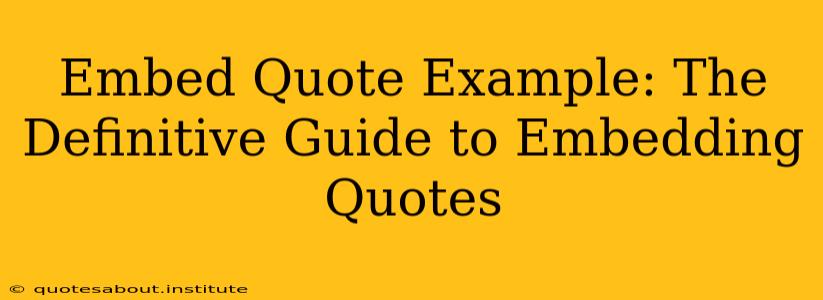Embedding quotes effectively can significantly enhance your writing. Whether you're crafting a blog post, academic paper, or even a social media update, strategically placed quotes add credibility, depth, and a touch of personality. This guide provides a definitive approach to embedding quotes, ensuring they're seamlessly integrated and add value to your content. We'll explore various styles, proper formatting, and best practices to make your quotes shine.
Why Embed Quotes?
Before diving into the mechanics, let's understand the power of embedded quotes. They serve several key purposes:
- Boost Credibility: Quoting experts or reputable sources instantly lends weight to your arguments. Readers are more likely to trust your claims when backed by authoritative voices.
- Add Depth and Nuance: Quotes can offer different perspectives, adding layers of complexity and enriching your analysis.
- Illustrate Points: A well-chosen quote can succinctly illustrate a point you're making, saving you lengthy explanations.
- Engage the Reader: Quotes can break up large blocks of text, making your content more visually appealing and easier to digest.
- Add Personality and Voice: Using quotes from compelling figures can inject personality and make your writing more memorable.
How to Embed Quotes Effectively: Different Styles
There are several ways to seamlessly embed quotes into your text. The best approach depends on the context and the length of the quote.
1. Short Quotes (Under 40 words):
Short quotes are typically integrated directly into the sentence using quotation marks.
Example: As Einstein famously stated, "Imagination is more important than knowledge."
Notice how the quote is seamlessly incorporated into the sentence structure. This works well for concise, impactful statements.
2. Longer Quotes (Over 40 words):
Longer quotes are typically set apart as block quotes. This improves readability and visual separation from the surrounding text.
Example:
"The process of scientific discovery is not a straightforward path. It is often characterized by setbacks, unexpected turns, and moments of profound insight that emerge from seemingly unrelated observations. The journey itself is as important as the destination." - Dr. Eleanor Vance, renowned physicist.
Observe the indentation and the absence of quotation marks in a block quote. Attribution usually follows the block quote.
3. Partial Quotes:
Sometimes, you only need a portion of a quote. Use ellipses (...) to indicate omitted words.
Example: In his acceptance speech, the Nobel laureate declared, "...a future where science and compassion work hand-in-hand..."
Use ellipses sparingly and ensure the meaning of the original quote isn't distorted.
4. Quotes Within Quotes:
If you need to embed a quote within another quote, use single quotation marks for the inner quote.
Example: She said, "The professor remarked, 'The experiment was a resounding success!'"
Essential Formatting Considerations
- Accurate Transcription: Always ensure that the quote is accurately transcribed from the original source.
- Proper Punctuation: Pay close attention to punctuation within and around the quote.
- Citation: Always cite the source of the quote. Use a consistent citation style (MLA, APA, Chicago, etc.). This is crucial for academic integrity.
Frequently Asked Questions (FAQs)
How do I cite a quote correctly?
Citation methods vary depending on the style guide you're following (MLA, APA, Chicago, etc.). Generally, you'll need to include the author's name, the year of publication, and the page number (if applicable).
What if the quote is longer than a paragraph?
For extremely long quotes, consider summarizing the key points instead of embedding the entire text. You can then cite the source.
Can I change the wording of a quote?
No, altering the wording of a quote is unethical and academically dishonest. It misrepresents the original author's message. If you need to adapt the quote, use paraphrasing instead and cite appropriately.
Where can I find credible sources for quotes?
Reliable sources for quotes include academic journals, books, reputable news outlets, and interviews with experts in the field.
By following these guidelines, you can effectively integrate quotes into your writing, adding credibility, depth, and engagement to your content. Remember to always cite your sources accurately and ethically.

